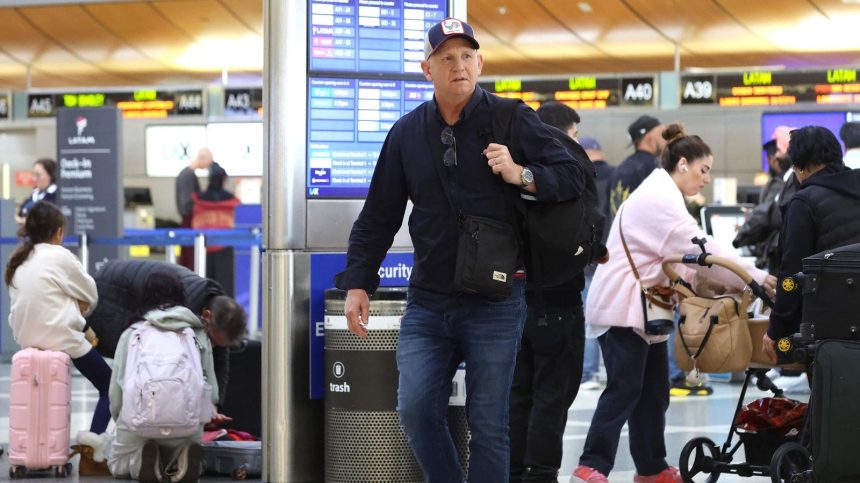The holiday season of 2023 witnessed a mix of festive cheer and travel disruptions as a series of storms, dense fog, and unusually warm temperatures swept across various parts of the United States. Millions of Americans embarking on post-Christmas journeys faced delays and cancellations, particularly in the Northwest, South, and Midwest. While the initial onslaught of severe weather began to subside by Friday, lingering effects and the threat of returning storms continued to pose challenges for travelers throughout the weekend.
The southern states bore the initial brunt of the turbulent weather. On Thursday, powerful storms lashed parts of Texas, Arkansas, and Louisiana, unleashing tornadoes and severe thunderstorms that significantly impacted air travel. Dallas-area airports were forced to implement ground stops, leading to widespread delays and disruptions. Although the intensity of the storms diminished by Friday, the National Weather Service warned of a potential resurgence on Saturday, particularly in areas around New Orleans, Lake Charles, Little Rock, and Fort Worth. The forecast indicated a continued threat of thunderstorms and heavy rain, raising concerns for travelers with weekend plans.
Beyond the storms in the South, dense fog advisories blanketed a large swathe of the country on Friday morning, further complicating travel conditions. Visibility was severely reduced in numerous states, including Texas, Wisconsin, Iowa, Maryland, Virginia, West Virginia, Nebraska, Kansas, Oklahoma, North Dakota, Florida, and Minnesota. This widespread fog posed a significant hazard for drivers, necessitating extra caution on the roads and potentially contributing to delays.
Meanwhile, the northwestern region of the U.S. and the northern Rocky Mountains braced for a different type of weather challenge. The National Weather Service predicted storms would move through these areas throughout the weekend, bringing heavy rainfall to parts of Washington, Oregon, and northern California. Accumulations of three to five inches of rain were anticipated by the end of the weekend, potentially leading to localized flooding and impacting travel plans in the region.
Adding to the complexity of the weather situation, much of the U.S. experienced unseasonably warm temperatures over the weekend. The National Weather Service forecasted record high morning temperatures in the central Plains, Mississippi Valley, Great Lakes, and mid-Atlantic regions, creating a stark contrast to the typical winter chill expected during this time of year. While the warmth might have been welcomed by some, it contributed to the overall instability of the weather patterns, potentially exacerbating the storms and fog conditions.
The combined impact of these varied weather events led to significant travel disruptions, particularly on Thursday. The storms and fog caused widespread flight delays, with over 8,000 flights delayed across the country. While the situation improved somewhat by Friday morning, with fewer major airports experiencing widespread delays, localized issues persisted. San Francisco International Airport reported delays of approximately 40 minutes due to weather, and other airports, such as those serving Aspen, Colorado, and Palm Beach, Florida, experienced more significant delays due to weather and increased volume. According to FlightAware, approximately 2,300 flights within, into, or out of the U.S. were delayed by Friday morning, with an additional 80 flights canceled. Despite the challenges, the holiday travel season continued apace, with over 15.2 million travelers passing through U.S. airport security checkpoints between December 21st and 26th. This number reflects the persistent demand for holiday travel, even in the face of adverse weather conditions. AAA predicted record-breaking travel numbers for the 2023 holiday season, with an estimated 119 million people traveling more than 50 miles between December 21st and January 1st, primarily by road. This massive influx of travelers, combined with the volatile weather patterns, created a complex and challenging travel landscape for many Americans. The widespread nature of the weather events, from storms and tornadoes in the South to dense fog in the Midwest and heavy rain in the Northwest, underscored the need for travelers to remain vigilant, check forecasts frequently, and be prepared for potential delays and disruptions. The unusually warm temperatures across much of the country added another layer of complexity to the situation, highlighting the unpredictable nature of weather patterns during the holiday season. Despite these challenges, millions of Americans pressed forward with their holiday travel plans, demonstrating the enduring importance of family and tradition during this special time of year.



